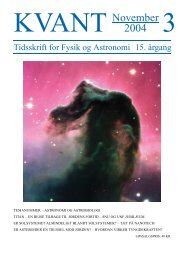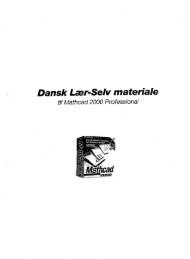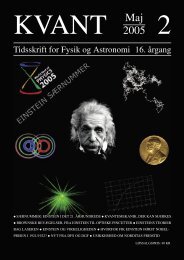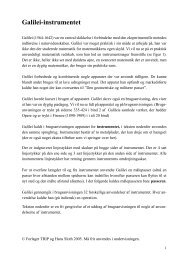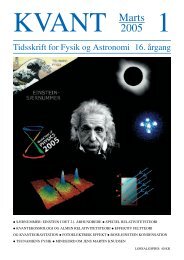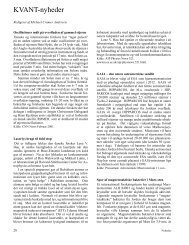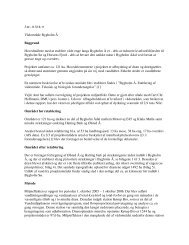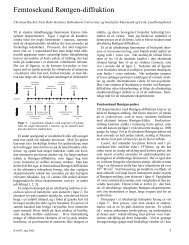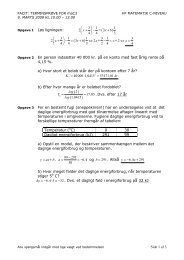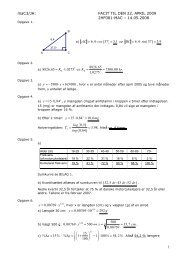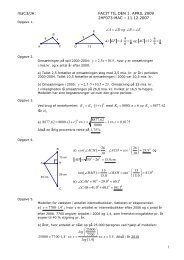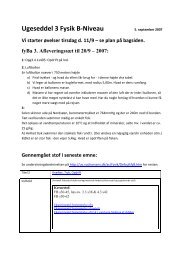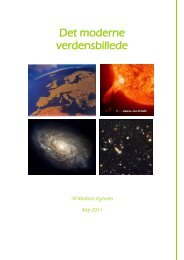Chapter 7 The Outer Planets
Chapter 7 The Outer Planets
Chapter 7 The Outer Planets
You also want an ePaper? Increase the reach of your titles
YUMPU automatically turns print PDFs into web optimized ePapers that Google loves.
196 <strong>Chapter</strong> 7 <strong>The</strong> <strong>Outer</strong> <strong>Planets</strong><br />
WEB LINK 7.8<br />
FIGURE 7-8 Comet Shoemaker-Levy 9 Debris Approaching Jupiter <strong>The</strong> comet was torn apart by<br />
Jupiter’s gravitational force on July 7, 1992, fracturing into at least 21 pieces. Returning debris, shown here<br />
in May 1994, struck Jupiter between July 16 and July 22, 1994. (H. A. Weaver, T. E. Smith, STScI and NASA)<br />
actually orbited Jupiter, rather than just orbiting the Sun.<br />
Calculations of the comet’s orbit showed that the pieces<br />
would return to strike Jupiter between July 16 and July 22,<br />
1994 (Figure 7-8).<br />
Recall from Essentials II that impacts were extremely<br />
common in the first 800 million years of the solar system’s<br />
existence. From more recent times, two chains of impact<br />
craters have been discovered on Earth, consistent with pieces<br />
of comets having hit our planet within the past 300 million<br />
years. However, it is very uncommon for pieces of space<br />
debris as large as several kilometers in diameter to collide<br />
with planets today. <strong>The</strong>refore, the discovery that Shoemaker-<br />
Levy 9 would hit Jupiter created great excitement in the<br />
astronomical community. Seeing how a planet and a comet<br />
respond to such an impact would allow astronomers to<br />
deduce information about the planet’s atmosphere and interior<br />
and also about the striking body’s properties.<br />
<strong>The</strong> impacts occurred as predicted, with most of Earth’s<br />
major telescopes—as well as those on several spacecraft—<br />
Io<br />
Great<br />
Red Spot<br />
Impact<br />
sites<br />
Aurora<br />
Aurora<br />
watching closely (Figure 7-9). At least 20 fragments from<br />
Shoemaker-Levy 9 struck Jupiter, and 15 of them had detectable<br />
impact sites. <strong>The</strong> impacts resulted in fireballs some<br />
10 km in diameter with temperatures of 7500 K, which is<br />
hotter than the surface of the Sun. Indeed, the largest fragment<br />
gave off as much energy as 600 million megatons of<br />
TNT, far more than the energy that could be released by all<br />
the nuclear weapons remaining on Earth, combined. Impacts<br />
were followed by crescent-shaped ejecta containing a<br />
variety of chemical compounds. Ripples or waves spread out<br />
from the impact sites through Jupiter’s clouds in splotches<br />
that lasted for months.<br />
<strong>The</strong> observations suggest that the pieces of comet did<br />
not penetrate very far into Jupiter’s upper cloud layer. This<br />
fact, in turn, suggests that the pieces were not much larger<br />
than a kilometer in diameter. <strong>The</strong> ejecta from each impact<br />
included a dark plume that rose high into Jupiter’s atmosphere.<br />
<strong>The</strong> darkness was apparently due to carbon compounds<br />
vaporized from the comet bodies. Also detected<br />
FIGURE 7-9 Three Impact Sites of Comet<br />
Shoemaker-Levy 9 on Jupiter Shown here are<br />
visible (left) and ultraviolet (right) images of Jupiter<br />
taken by the Hubble Space Telescope after three<br />
pieces of Comet Shoemaker-Levy 9 struck the<br />
planet. <strong>The</strong> astronomers had expected white<br />
remnants (the color of condensing ammonia or<br />
water vapor); the darkness of the impact sites may<br />
have come from carbon compounds in the comet<br />
debris. Note the auroras in the ultraviolet image.<br />
Auroras and lightning are common on Jupiter, due<br />
in part to the planet’s strong magnetic fields and<br />
dynamic cloud motions. (NASA)




